Kunzite! Specifically, California Kunzite......
So what does this beautiful pinkish, purply pink gemstone have to do with a mine in Southern California that sits in the middle of a famous mining area, whose names such as the Tourmaline Queen, the Tourmaline King, The Stewart and others are well known to those who collect minerals and gems? The answer is simple - Everything!....
This story begins with the owner of All That Glitters meeting up with a California rough dealer in mid-July 2011 at a show in Massachusetts. This rough dealer has been known to All That Glitters for decades, having met in the late 1980s. He was attending a show in New England and Mr. Brown, the owner of All That Glitters, decided to drive out to talk with those in the trade to see how business was and if there was any gemstone related news. Mr. Brown showed this dealer a fine large Ruby which the other dealer thought would wholesale for about twice the current asking price. The conversation continued and Mr. Brown moved on to see other dealers he knew, to browse items that were being sold and also to view the mineral specimens on display in this particular show. After a few hours, it was time to leave but what seemed to be a familiar face in the crowd was spotted in the distance. This was a gemstone dealer and cutter from CT whom Mr. Brown had offered to split a booth back in the early 1980s. Though he they had conversed on the phone and emailed, a conversation in person hadn't occurred in perhaps 15 years. Mr. Brown sought him out on the floor and found him talking to that original dealer from CA. Conversations between all three individuals began, and in spending more time there, a discussion began on a few pieces of Spodumene (Kunzite) from CA. The dealer had obtained two crystals of Kunzite directly from the mine, with the first one being sliced for cutting and the 2nd crystal was still intact but was going to be sliced also. The color of this material was good, had clean sections and was from an important pocket called the Big Kahuna II, found only several months back in an actively worked mine called the Oceanview Mine in the Pala area of CA. Mr. Brown was on his way out of the show, but through odd events, he stumbled on to something unique and that he felt comfortable putting into inventory. Gemstones from the United States are actively sought out by collectors, and if this one piece of rough Kunzite could be fashioned into a beautiful gemstone, this would become an important gemstone due to several factors.
The rough piece of Kunzite was sent off to All That
Glitters' Award Winning Master Cutter - Stephen Kotlowski. After some time, the result was revealed - a stunning
18.85ct Oval Kunzite with a super color. In fact, to quote our cutters comments and to give the
readers an idea of weight loss, yield, etc. we have copied
parts of this email below:
Subject of the email: Finished the Kunzite and its Fabulous!!
Well its finally finished and it's spectacular!!
Attached is a set of photos starting from the 3rd recut of the pavilion at 1200 to the final recut... at 8000 just before polish and then finally the finished stone. (100k final polish - ATG Note)
So here are the results:
Rough wt: 102.15cts
Preform oval wt: 55cts
Final wt: 18.85cts
Recovery: 18.5% from rough
20.4 x 13.8 x 10.0mm (very settable not deep at all and a fabulous deep color)
I can't wait to see this in natural daylight as it's very brilliant now in the lighting in my apartment and this just glows in a very darkly lit view, the color is outstanding a purplish/bluish deep pink.
I'd say after looking at the Guide and having this stone cut by me I would say it was valued around $200+/ct wholesale, which would make it at least a $3,770 stone.
Weight loss was higher than expected as there are typically problems
when cutting gemstones that typically have inclusions and
cleavage. This piece was unique due to color, expertly
faceted with every facet junction meeting perfectly, and
originated in an important pocket of a CA mine - all factors
of importance for someone seeking a gemstone mined in the
United States. Several museums were contacted to see
if there was interest in acquiring this piece for their
gemstone collection; this included the San Diego Natural
History Museum which had an ongoing exhibit called - All
That Glitters. (http://www.sdnhm.org/exhibitions/current-exhibitions/)
Our email to this institution was forwarded to the volunteer
curator of the gem and mineral collection, Mark Mauthner,
who also happens to be involved with the folks at the
Oceanview Mine. The fact the company name was All That
Glitters and that a really nice looking gemstone from this
mine was being offered for sale, raised some flags for a
number of reasons, including the fact that little rough had
been sold or released. Wearing both his Museum and
Oceanview Mine hats, Mark contacted Mr. Brown to make a few
inquiries. When the origin of the piece of rough was
revealed and other details discussed, what was probably
expected to be a short conversation ended up lasting about
an hour as the conversation spanned everything from
gemstones, photography, travel abroad, minerals and people
that were known by both.
In discussing the mine itself and the fact that Mr. Brown
would be in the All That Glitters CA office in a few
more months, an invite to visit the mine was extended.
Mr. Brown drove from Northern CA down to the San Diego area
(while on route to the Tucson Show) where he got a personal
tour of the All That Glitters exhibit in the San Diego
History Museum just prior to the doors opening officially
for that day. Later, it was off to GIA Headquarters in
Carlsbad to view the museum they have just off the
lobby. In early afternoon, we drove up to the
Oceanview Mine in the Pala area. The first thing that
one encounters in the vicinity of the mine, is an area where
people can pay a fee to sift through rock removed from the
mine; there are a number of species to be found. Later
in the day we saw this material outside of the mine awaiting
removal to the the sifting area, and there were Spodumene
Crystals visible - so it seems that one can certainly find
some interesting pieces. The sifting area also has
water and rest rooms. After Mark discussed what
goes on in the sifting area, we awaited Jeff Swanger(the
mine owner) to arrive.
Once Jeff arrived, we took a small vehicle up to a residence
on Chief Mountain that overlooks the hills, many of which
contain mines; in fact, it overlooks some of the mines
mentioned earlier. On a clear day, one can see the
Pacific Ocean from here - thus the name, Oceanview.
(Just below this residence are the original Pala Chief Mine
tunnels and another residence related to the site, currently
being renovated; this looks like it will be a great place to
stay in the future for those that might be mining or
prospecting.) Mr. Brown was shown both Kunzite
(Pink Spodumene) and Triphane (Yellow Spodumene)
crystals. There were also some pieces of local
Tourmaline rough recently purchased from an older gentleman
who had mined the area decades earlier (some of this
material was from the Stewart Mine - famous for it's Pink
Tourmaline, which is rarely clean, but very sought
after). We put on hard hats and then drove the vehicle
down to the very much anticipated Oceanview Mine.
After unlocking the gate to the entrance to the mine, all
three entered the tunnel, walking through an area that had
been the Big Kahuna and Big Kahuna II pockets and ended up
at the far back where active mining was occurring.
There were a number of raises and pockets during the walk to
the face. (Note: the working area of a mine is known
as the "face" or "heading", the "back" is the roof.)
Jeff was very excited about the face as it showed VERY good
signs that something could be encountered shortly. He
wet down the walls to allow better viewing of the material
in the walls. The largest area of lepidolilte that
Jeff had seen was off to our right - measuring about 6 feet
wide. Decomposed Spodumene littered the walls.
Picking off some small fragments of the wall, one could see
Watermelon Tourmaline. Small digging tools clung to
the wall where a miner had left them the previous day.
Mark agreed with Jeff in that something good could be around
the corner (or at least several feet further) after some
more blasting was due in the following days. One can
also see the yellow tubing in some areas that brings in
clean air from the outside. As our small group of
three headed out, a pocket to the right showed
crystallization (large smoky quartz clusters) with the
potential of other material being found just further
in.
Pala Chief Mine was next to visit and that was back up and
around the hill slightly. Again, after opening the locked
steel door, we entered an adit on the second level, just
down from the residence we were previously in. The
view from this area overlooks the same area as the
residences just above. Muck (blasted rock) from these
workings sat just outside awaiting removal down to the
public sifting area, and if one looked carefully, Triphane
crystals were visible. This adit is not as long as the
Oceanview but is also being actively mined.
(Note - an "adit" is a more or less level and straight
tunnel that reaches the surface at a "portal". A departure
in direction underground, turns the new segment into a
"drift" or "crosscut" depending on whether or not the ore
body is intersected.) Smoky Quartz crystals were to be
seen here also, and tools were left in place from the last
time someone was literally exploring what had been
unearthed. There are high hopes for this mine also.
The Pala Chief is world famous for the Kunzite specimens it
produced, which were the world's best until the discoveries
in Brazil, then followed by Afghanistan. Kunzite is
absolutely gorgeous in color, being a deep purple blue down
the C axis, and greenish and light purple down the A and B
axes. Like most (if not all) naturally occurring
Kunzite, the intense color fades over time with exposure to
light, but apparently the material found in the Oceanview
mine in the last few years stabilizes once it has turned
pink from the original purple, green/purple or greenish.
Mark has had pieces from the Big Kahuna find sitting in the
sun since its unearthing in the summer of 2010. It has not
changed from the pink it achieved within a couple of days of
sitting in the full sun. However, Kunzite has always
been an 'evening' gemstone and limiting its exposure to the
sun (UV light), the color will be fairly stable. It is
Ultraviolet light that will cause it to lighten. There
are a number of gemstones can fade upon exposure to sunlight
after seeing the light of day after millions of years - and
that can include Amethyst, Topaz among others. To
quote some information found on line - "Kunzite is a
relatively recent gemstone, having been first discovered
in the 20th century. It was first found in the pegmatites of Pala, California, in
1902, and is named after the famous mineralogist
George F. Kunz who first identified it. Though it wasn't
until the 1990's that this gemstone became a more
mainstream gemstone, having been used only as a collectors
gemstone prior to that time. Kunzite is a very
attractive pink gem, but is notorious for its habit of
color fading in prolonged exposure to strong light.
Although the color-fading effect is very slow, most people
still prefer to wear Kunzite jewelery in the evening to
avoid sunlight exposure. Kunzite is regarded as an evening
stone for this reason." Mark has
noted "the dark purple Oceanview fades within hours
in the full sun to pink and then is stable. Pink
Afghanistan material fades completely over time to colorless." Many
Kunzites on the market owe their color to irradiation
which produces a medium pink color - just another of
the many forms of enhancement that gemstones may be
exposed to and many times without disclosure.
Kunzite (and all colors of Spodumene) has cleavage like
Diamond, Diaspore, Topaz and other gemstones. This
particular gemstone would be best to wear as a
pendant. Little rivals the beautiful color pink of
the various saturations of this gemstone. With some
care, the original color can be maintained and this
beautiful gemstone can be passed on to future generations.
Many thanks go out to Mark's hospitality that I was shown
during my whirlwind tour of the Natural History Museums
All That Glliters Exhibition, as well as GIA's museum; a
tour of the Oceanview Mine as well as the Pala Chief Mine
would not have been possible without Mark's help and
guidance. Special thanks also go out to Jeff who
owns these mines and whose insight and information during
my tour is priceless. I look forward to hearing
about future finds. One never knows what is just a
few feet further as the miners on Chief Mountain continue
into the gem/mineral bearing rock.
For more information on the mines and to 'dig for gems',
you can visit their web site at:
http://www.digforgems.com
| California Kunzite from
the Oceanview Mine, the Big Kahuna II Pocket! |
|
 |
|
 |
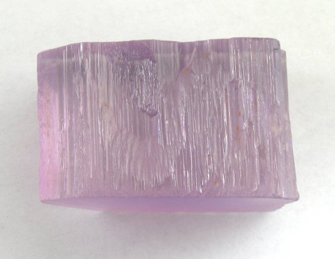 |
 |
|
| 18.85cts - Shape is a custom design faceted by our Award Winning Master Cutter(Stephen Kotlowski) and is called - Uniquely K Ultima Oval 20.4 x 13.8 x 10.0mm ("very settable not deep at all and a fabulous deep color" - quote from our master cutter) SOLD!(PBB) | |
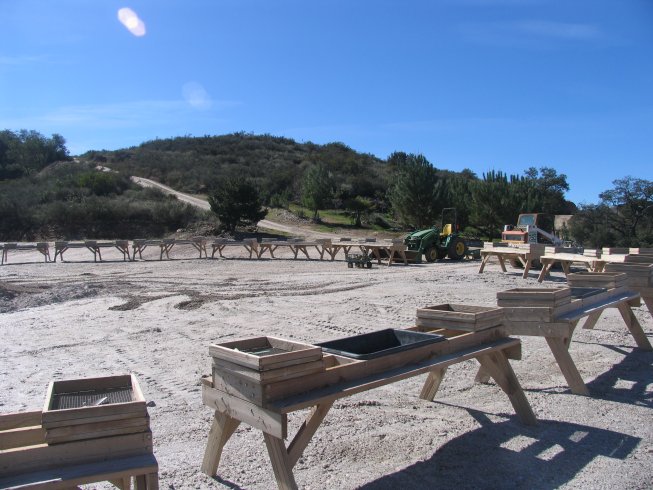 |
| Screening Area Open
to the Public for a small fee |
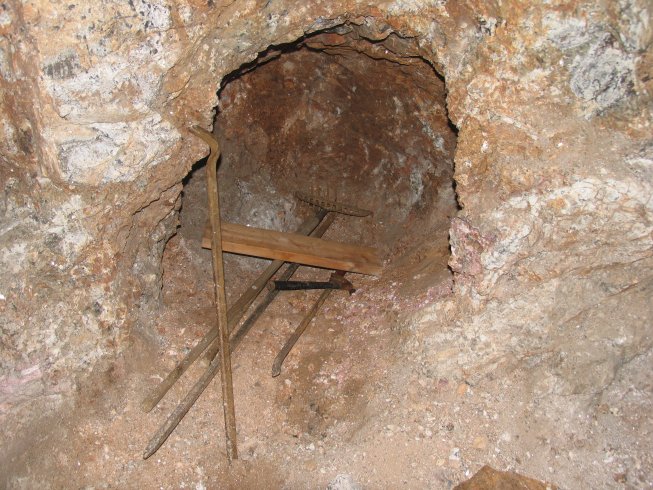 |
| Example of tools used
to scrap out pockets (Oceanview) |
 |
| Air Supply required to side tunnels (currently not active in this photo) (Oceanview) |
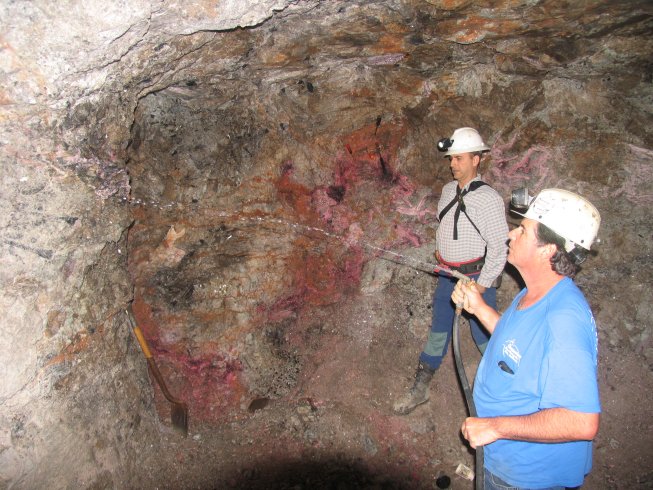 |
| Jeff wetting the walls of the face so it is easier to see various minerals, crystals and type of rock present (Oceanview) |
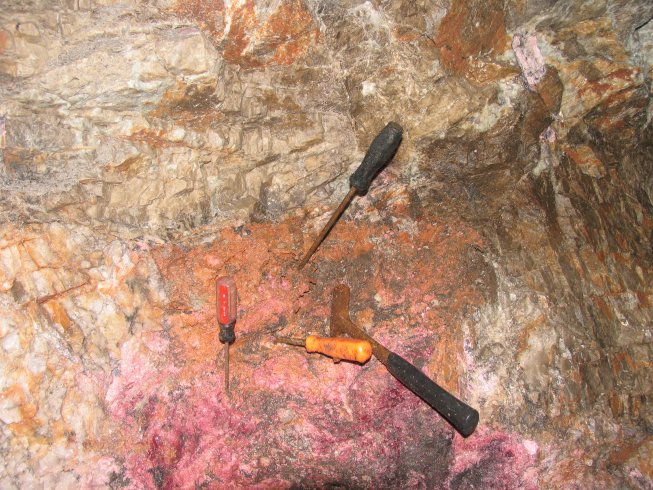 |
| Small hand tools for carefully removing items found or moving slowly ahead in an area of mineralization (Oceanview) |
 |
| Decomposed Spodumene (Oceanview) |
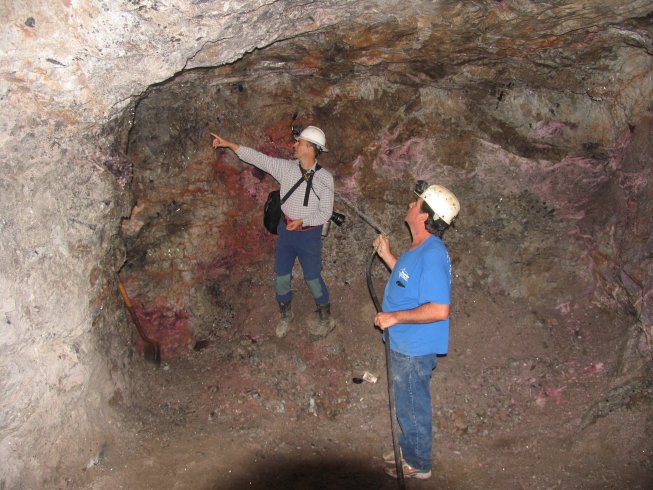 |
| Mark pointing out an area of interest (Oceanview) |
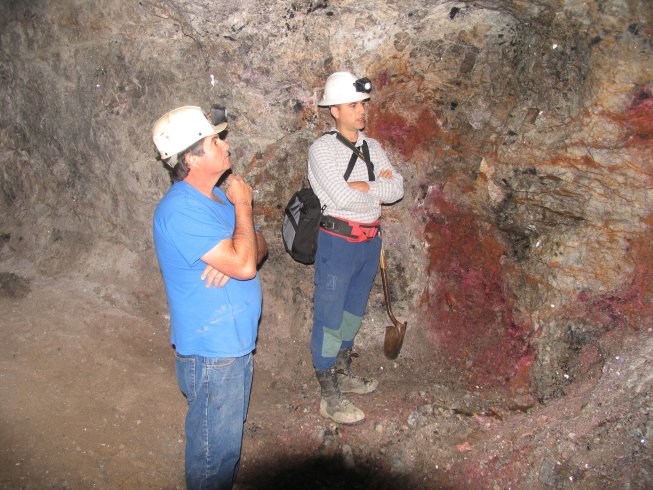 |
| Jeff and Mark looking
at far end where the future looked quite bright due
to the large amounts of mineralization (they had never seen it look so promising previously) (Oceanview) |
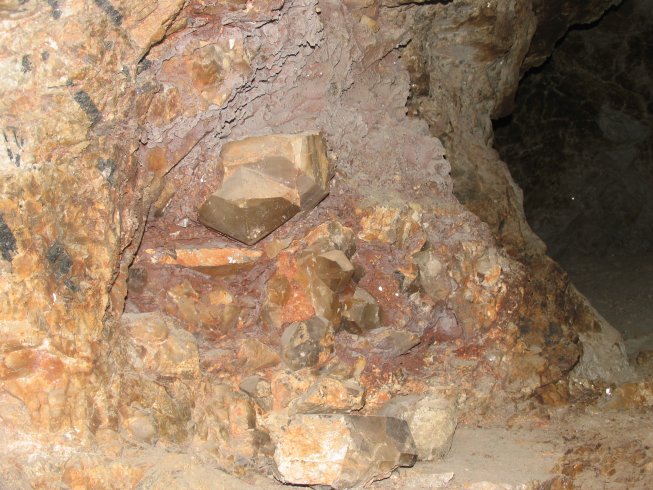 |
| Large Smoky Quartz Crystal Cluster at the entrance to a side tunnel that needs exploring and further mining (Oceanview) |
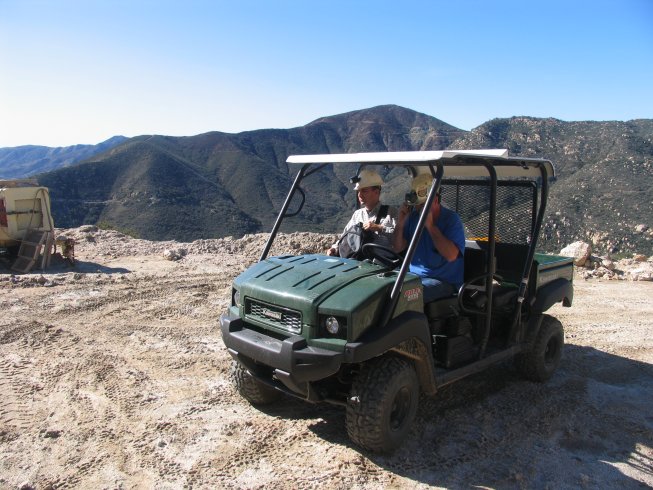 |
| Arriving at the Pala
Chief Mine - other important mines can be seen
in hills from this vantage point |
 |
| Entrance to the Pala
Chief Mine |
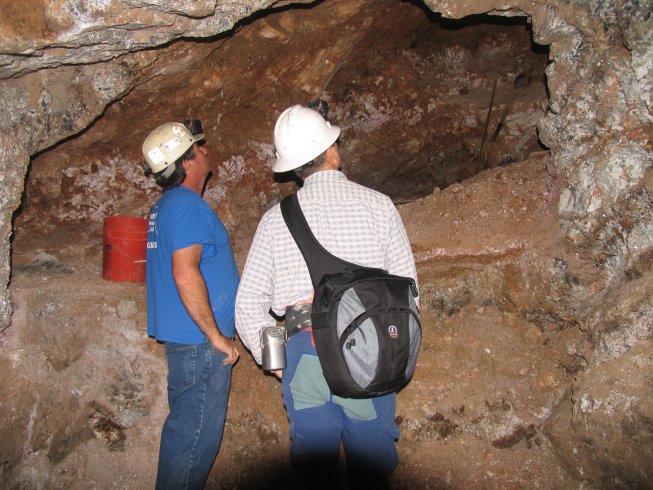 |
| Far end (face) of the
Pala Chief Mine - Smoky Quartz Crystals could be seen
and this would be the next area to blast (Pala Chief) |
Photographs by: L. Allen Brown, All That Glitters (Copyright: LAB/ATG) |
This area of California is rich in mineralization, mines and
gemstone history. The Pala District consists of three mountains:
Queen Mountain: Tourmaline Queen Mine, Tourmaline King Mine,
Stewart Lithia Mine, Gem Star Mine, Little Joe Mine, Stewart
Extension, Ed Fletcher Mine
Chief Mountain: Pala Chief Mine, Elizabeth R Mine, Oceanview
Mine
Hiriart Mountain: White Queen Mine, Katerina Mine,
Vandenberg Mine, San Pedro Mine, Anita Mine, Fargo Mine, El
Molino Mine.
To quote Wikipedia on Pala, California:
China's Dowager Empress Cixi of Qing Dynasty highly prized the pink tourmaline mined in Pala. Under her influence, China's appetite for this gem created a boom in the California tourmaline industry after 1902, particularly at the Himalaya mine, ending in 1911, shortly after the Empress died in 1908.
Pala was the site where morganite beryl was first discovered. It was also discovered in 1902 as the first commercially significant deposit of kunzite, named after George F. Kunz, the godfather of gemology.
On December 3rd, 2009, another bonanza pocket was
discovered... This basketball-sized pocket produced several
deep purple and lavender kunzite crystals, the largest
measuring approximately 7.4cm wide, being doubly terminated,
along with many fine gem-quality green and bicolored
spodumene crystal lathes and shards. Nearly all of the
kunzite recovered exhibited strong green to purple
trichroism. Other accessory minerals recovered adjacent to
this pocket included several small pale blue to dark
blue-capped tourmaline crystals, lepidolite and
cleavelandite.
Underground work continued along the zone of lithia
mineralization, which led to the discovery of additional
kunzite pockets in the spring of 2010. In this area, dubbed
the "Big Kahuna" zone in honor of Swanger's father, hundreds
of kilograms of gem spodumene were produced, including one
large crystal lathe measuring approximately 21cm tall, and
weighing nearly one kilogram. Minor amounts of green, blue
and pink tourmaline were also discovered, including some
fine bicolor pink and green pencils. The largest reported
tourmaline found measured aproximately 15cm tall and 3-4cm
wide. Additionally, several beryl specimens were also
discovered, although beryl was notably rare in this zone.
One tabular morganite crystal recovered measured 7cm across,
associated with a small "blue-cap" pink tourmaline.
In December of 2010, another large kunzite pocket was
discovered down dip from the Big Kahuna zone, and thus named
the "Big Kahuna II". Although not as productive in
comparison to the sheer volume of material produced from the
first pocket, the color of this spodumene was generally a
more deeply saturated hue, and exhibited strong pleochroism.
Several deep colored pink and cranberry red color-zoned
tourmaline specimens were also found, some associated with a
matrix of albite and lepidolite. Adjacent satellite pockets
produced specimens of citrine and smoky quartz, some so
deeply colored that they appeared black or otherwise opaque.
Watch a Kunzite from the Oceanview Mine being faceted over a
weeks timeframe.
Observe some of the the issues and problems that arise
when faceting....
< Faceting
Kunzite Demo >